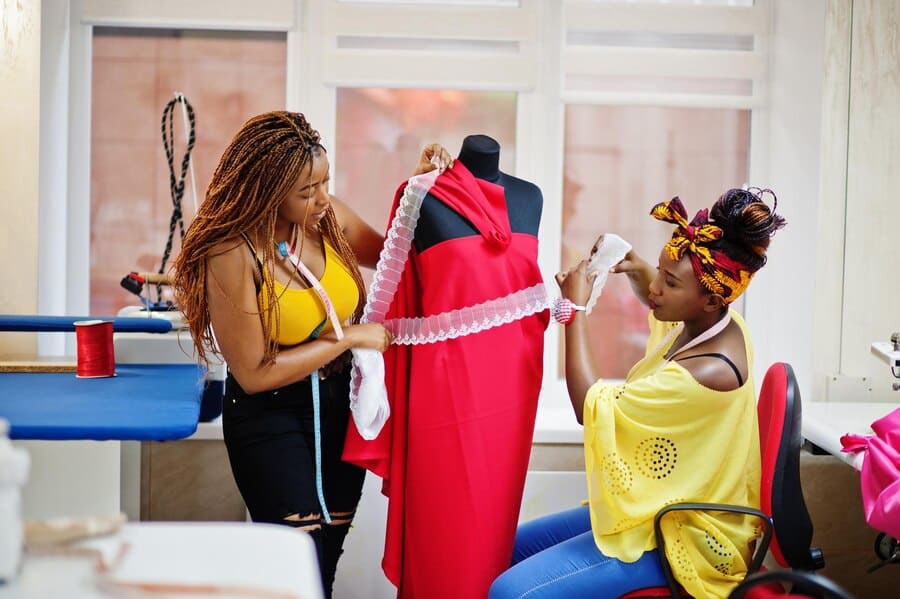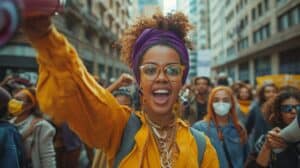
Discover the Vibrant Creativity of African Fashion Designers
As the sun sets over Lagos, a wave of excitement fills the air. In a hidden studio, fashion lovers come together to see Lisa Folawiyo’s latest pieces.
They are amazed by the bright colors and detailed designs, showing the beauty of African fashion.1
This buzz isn’t just in Nigeria. All over Africa, a new era of creativity has begun in fashion.
It pulls in people from around the world with its vivid colors and unique patterns.
Designers like Ozwald Boateng in London and Maxhosa by Laduma in South Africa are sharing African creativity with the globe.

Leading this change is the Africa Fashion exhibition at the Victoria & Albert Museum in London.
It features work from 45 designers across Africa. This makes it the UK’s biggest show of African fashion yet.
The exhibit shows how fashion, music, and art play a huge role in African culture, shaping the world of fashion today.
The showcase highlights African fashion as a deep reflection of history and culture. It fights against one-sided views and welcomes everyone to see beauty in new ways.
This starts important conversations about what beauty and style really mean.
Key Takeaways
- African fashion has gained global recognition for its vibrant colors, bold patterns, and unique designs.
- Designers like Ozwald Boateng, Deola Sagoe, and Maxhosa by Laduma are leading the charge in showcasing the innovation and creativity of African fashion.
- The Africa Fashion exhibition at the Victoria & Albert Museum celebrates the richness and diversity of African fashion, challenging stereotypes and promoting inclusivity.
- African fashion designers are preserving cultural heritage while creating contemporary designs that cater to global fashion trends.
- The African fashion industry is empowering local artisans, weavers, and craftsmen, providing economic opportunities, and preserving cultural traditions.
Exploring the Vibrant World of African Textiles
Africa’s textile and fashion legacy dates back centuries. It’s rich in culture, bright colors, and detailed designs.2
These fabrics symbolize identity, status, and tradition, not just clothes.3 In recent times, global interest in African fashion textiles has surged.
Designers add modern twists to these traditional textiles, catching the eye of many.3
Kente Cloth: Symbols of Pride and Identity
Kente cloth comes from Ghana’s Ashanti people. It’s not just a fabric; it’s cultural pride and identity.2
The weaving method called “double weave” shows the weavers’ skill.
The detailed patterns and colors might take weeks or months to make.2
Bògòlanfini: Ancient Malian Textile Tradition
Mudcloth, or Bògòlanfini, is Mali’s ancient textile art. It uses earthen colors and special designs.2 People in Mali hand-paint cotton cloth with mud and dyes.
This shows the Bamana people’s creative side.2
Adire Textiles: Yoruba Artistry and Resist-Dyeing
The Yoruba in Nigeria are known for Adire textiles. They use various resist-dye methods to make unique designs.2 These textiles reflect Africa’s natural beauty.
Now, they’re popular worldwide.3
Ankara Fabrics: Fusion of Tradition and Innovation
Ankara is an African wax print fabric. It combines African techniques with European influence.2 Its wax-resist dyeing and patterns make Ankara famous worldwide.3
Today, designers mix African textiles with modern fashion, showing the fabrics’ versatility.3
African fashion is rooted in ancient traditions. It shows off unique patterns, bright colors, and local textiles.4
Designers such as Lisa Folawiyo, Taibo Bacar, and Duro Olowu are famous for mixing traditional and modern African prints.4 African fashion’s influence reaches far, inspiring trends and designers around the globe.4
African Fashion Pioneers: Trailblazers and Innovators
African fashion designers have made a big impact on the fashion world.1
Duro Olowu, Nigerian-born and based in London, is famous for his bold prints. He uses vibrant designs that mix his Nigerian background with a modern look.1
Ozwald Boateng, from Britain with Ghanaian roots, changed men’s tailoring. He added bold colors and sharp cuts, redefining what men’s fashion could be.
Duro Olowu: Bold Prints and Vibrant Designs
Duro Olowu stands out among Africa’s fashion pioneers and fashion innovators.
His work combines his Nigerian culture with today’s global style. This creates designs that are beautiful and meaningful.
Ozwald Boateng: Revolutionizing Men’s Tailoring
Ozwald Boateng is a fashion trailblazer from Africa. He has changed the look of men’s suits with his creative style. Using bright colors and sharp shapes, he has made a big impact.
His suits are now must-haves for those who love fashion.

African Fashion Designers: Celebrating Vibrant Creativity
Lisa Folawiyo: Elevating Ankara Fabrics
In Lagos, Nigeria, Lisa Folawiyo is a star of the fashion scene. She takes Ankara fabrics, a staple of African fashion, and gives them a modern twist.
She adds beautiful beadwork and embroidery to these fabrics, turning them into stunning pieces.5 Her work stands out, not just in Africa, but globally too, in the world of fashion.
Tongoro Studio: Sustainable and Ethical Fashion
Sarah Diouf’s Tongoro Studio is based in Senegal. It stands out for being all about sustainable fashion and ethically made clothes.
They work closely with local artists and use materials found nearby.
This way, they’re not only putting out beautiful clothes.
They’re also helping the local economy and the environment. Tongoro Studio shines bright in the world of african fashion designers creativity.
| Designer | Origin | Signature Style |
|---|---|---|
| Lisa Folawiyo | Nigeria | Contemporary Ankara fabrics with intricate beadwork and embroidery |
| Sarah Diouf (Tongoro Studio) | Senegal | Sustainable and ethical fashion, collaborating with local artisans |
| Kenneth Ize | Nigeria | Contemporary take on traditional West African textiles and craftsmanship |
| Thebe Magugu | South Africa | Designs rooted in South African identity and culture, LVMH Prize winner |
| Christie Brown | Ghana | Fusion of African prints with modern tailoring techniques |
The Cultural Significance of African Textiles
African textiles are very important culturally and spiritually. They use specific patterns and colors for different events.
These events can be weddings, funerals, or religious ceremonies.6 The fabrics aren’t just for wearing.
They’re symbols of who people are, their place in society, and their heritage. This shows how diverse and vibrant life is across the continent.6
Textiles as Symbols of Identity and Status
Textiles show a person’s or group’s status, wealth, and identity. For instance, the Kente cloth of the Akan people in Ghana is for royalty and important people.
It marks their power and standing in society.6 Similarly, the Adire cloth from Nigeria shows how well off and respected Yoruba women are in their community.6
Communal Tradition and Intergenerational Knowledge
The making of textiles often involves a whole community. It’s a way for people to connect and learn from each other.
Women are usually the ones leading this craft, teaching the traditions and designs through the years.6 This sharing of knowledge across generations plays a big part in keeping African textile culture alive.6
Contemporary African Fashion on the Global Stage
In recent years, African fashion and textiles have captured worldwide attention. They are known for their one-of-a-kind designs, bright colors, and deep cultural roots.7
The sector is expected to grow by 12.14% from 2023 to 2027, hitting US$10.12 billion in 2027.7 This growth highlights African fashion’s increasing influence globally.
Challenging Stereotypes and Promoting Inclusivity
African designers merge traditional elements with modern fashion. This fusion highlights Africa’s creativity and innovation.8
Their designs challenge beauty standards and encourage a broader, more accurate view of beauty and style.7
African fashion events, weeks, and runways have seen a sharp rise. These platforms allow African designers to shine worldwide and transform the fashion scene back home.7
Preserving and Celebrating Cultural Heritage
African fashion designers showcase the importance of textiles and historical context. They make stunning clothes that reflect the continent’s rich cultural history.8
Designers like Emmanuel Okoro from Nigeria and Nkwo Onwuka are infusing traditional textiles with new life.8
This not only highlights the scope of African fashion but also respects the arts and knowledge behind it.
Source Links
- https://www.linkedin.com/pulse/journey-african-fashion-exploring-styles-designs-cultural-expressions
- https://www.insidefashiondesign.com/post/celebrating-african-textiles-and-fashion-a-rich-history-and-modern-influence
- https://ct101.commons.gc.cuny.edu/exploring-the-vibrant-world-of-african-fashion-textiles/
- https://www.linkedin.com/pulse/exploring-vibrant-world-african-fashion-osharede-lifestyle-qyd2e
- https://www.diyanu.com/blogs/fashion/top-african-fashion-designers-making-waves-in-the-industry
- https://larryrowbsfoundation.org/blog/role-of-african-textiles-in-african-culture-and-identity
- https://www.eyecity.africa/post/the-global-influence-of-african-fashion
- https://tlmagazine.com/common-threads-contemporary-african-fashion/






